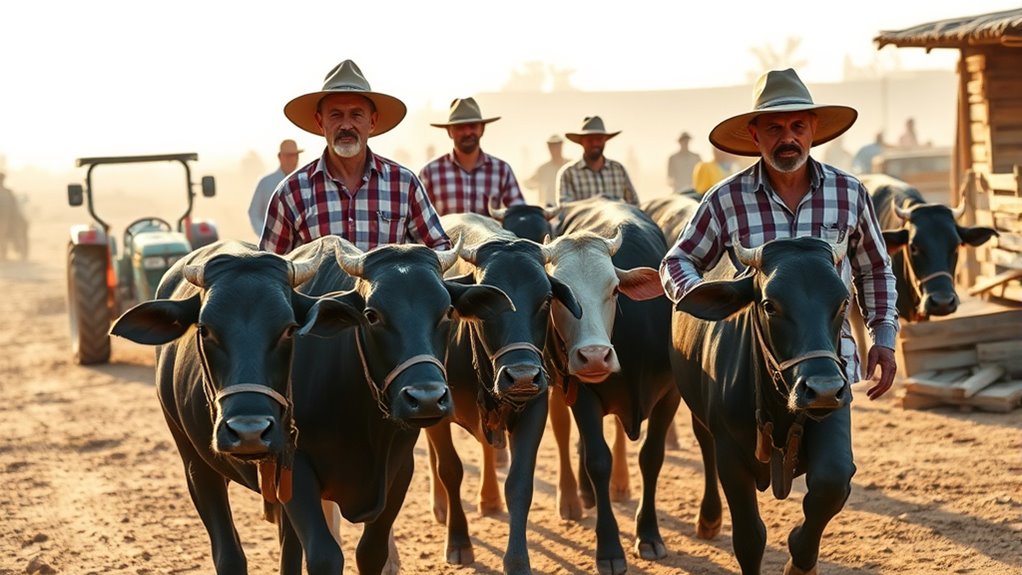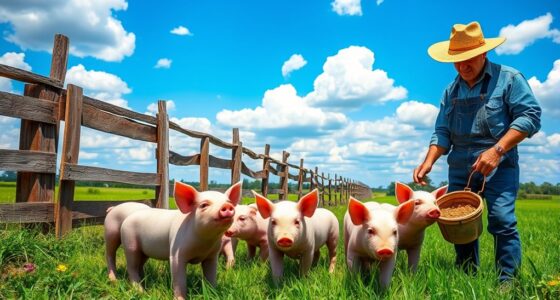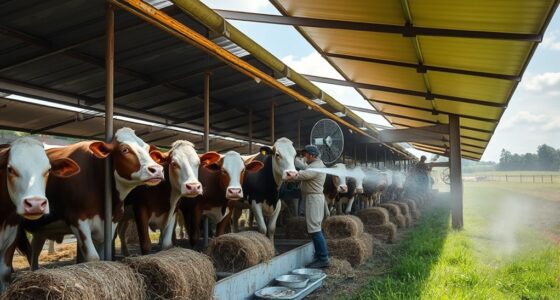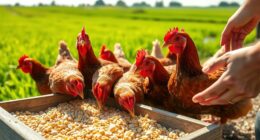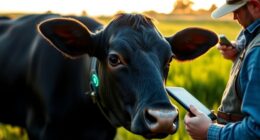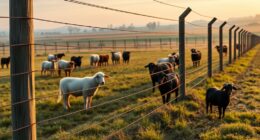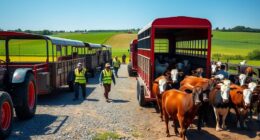To prepare livestock for transport during market season, you should first assess their health and fitness, guaranteeing they are free of illness or injuries. Adjust feeding and watering schedules to keep them hydrated and well-nourished, and handle them calmly to reduce stress. Choose proper transport equipment and load animals carefully, securing their safety. Keep all permits and health documents up-to-date. Planning for emergencies and understanding regulations help ensure smooth transit. For detailed tips, keep exploring these key steps.
Key Takeaways
- Ensure all health certificates, vaccination records, and permits are current and properly documented.
- Conduct pre-transport health and fitness assessments to prevent disease spread and ensure animal well-being.
- Select suitable, well-ventilated vehicles with proper loading and safety equipment.
- Minimize stress through calm handling, smooth vehicle operation, and proper loading procedures.
- Prepare an emergency plan with necessary supplies to address potential breakdowns or weather issues during transit.
Assessing Animal Health and Fitness Before Loading
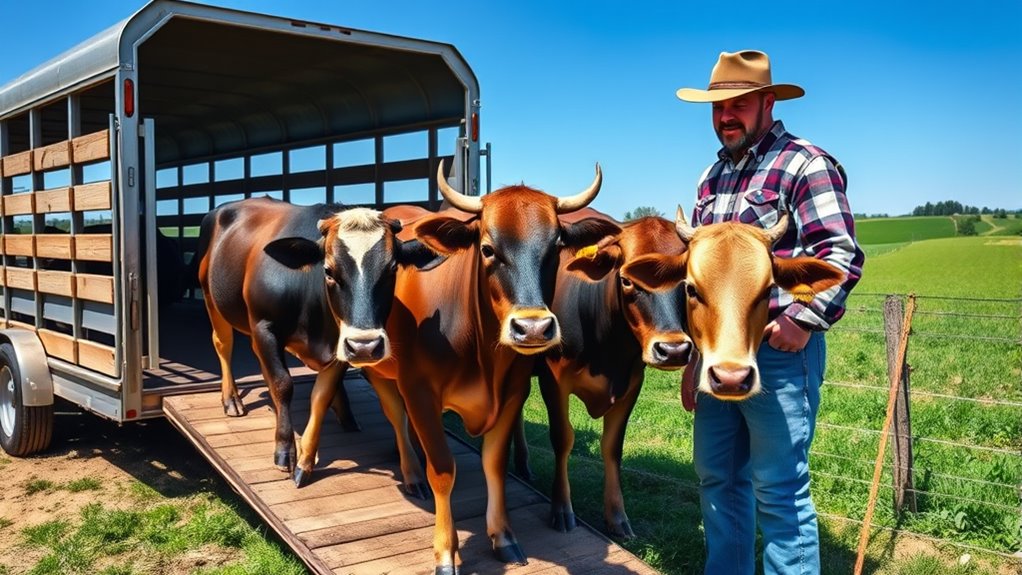
Before loading livestock, it’s crucial to evaluate their health and fitness to guarantee they can endure transportation. Start by inspecting each animal for signs of illness or injury, such as labored breathing, lameness, or visible wounds. Check their eyes, nose, and mouth for discharge or abnormalities. Observe their behavior; lethargic or overly stressed animals may not be fit for travel. Ensure animals are well-hydrated and have a healthy appetite, indicating good overall health. If any animals show signs of illness or weakness, consult a veterinarian before proceeding. Transport regulations should also be reviewed to ensure compliance with local and federal requirements. Properly assessing each animal helps prevent health issues during transit, reduces stress, and ensures compliance with transport regulations. Taking these steps ensures your livestock arrives at the destination safely and in good condition.
Ensuring Proper Nutrition and Hydration Leading Up to Transport

To prepare your livestock for transport, you need to adjust their feeding schedules so they’re not overly full or hungry during the trip. Always make certain they have access to fresh water to stay hydrated and comfortable. Proper nutrition and hydration help reduce stress and support their overall well-being during transit. Considering proper equipment like suitable containers and feeders can also facilitate better care during transport.
Adjust Feeding Schedules
Adjusting feeding schedules is crucial to guarantee livestock stay properly nourished and hydrated before transport. You should gradually modify their feed intake in the days leading up to departure, avoiding sudden changes that can cause digestive issues. Reduce the amount of feed slightly to prevent bloating and discomfort during transit, but ensure they still receive enough nutrients to stay healthy. Focus on feeding high-quality forage and grains that support energy levels without overloading their digestive system. Maintain consistent feeding times to help animals adapt to routine changes smoothly. Remember, a well-planned feeding schedule minimizes stress and guarantees your livestock remain in good condition, ready for a safe and efficient journey. Proper adjustment of their diet is key to successful transport preparation. Additionally, understanding the dynamics of real couples can help owners better recognize signs of stress or discomfort in their animals, ensuring more attentive care during this critical period.
Provide Fresh Water
Have you guaranteed your livestock have access to clean, fresh water in the days leading up to transport? Proper hydration is crucial to keep your animals healthy and stress-free. Ensure water sources are clean and easily accessible at all times. Check that water containers are functioning properly and free of contaminants. Encourage frequent drinking by maintaining consistent water availability, especially during hot weather. Well-hydrated animals are less likely to become dehydrated or stressed during transport, which helps prevent health issues. Keep in mind that sudden changes in water quality or availability can cause discomfort. Consequently, establish a reliable water supply that your livestock can access regularly in the days before loading. This simple step supports overall well-being and smooths the transition during transport. Monitoring payment processing systems can help ensure that all transactions related to livestock sales and transportation arrangements are secure and efficient.
Selecting the Appropriate Transportation Equipment and Vehicles
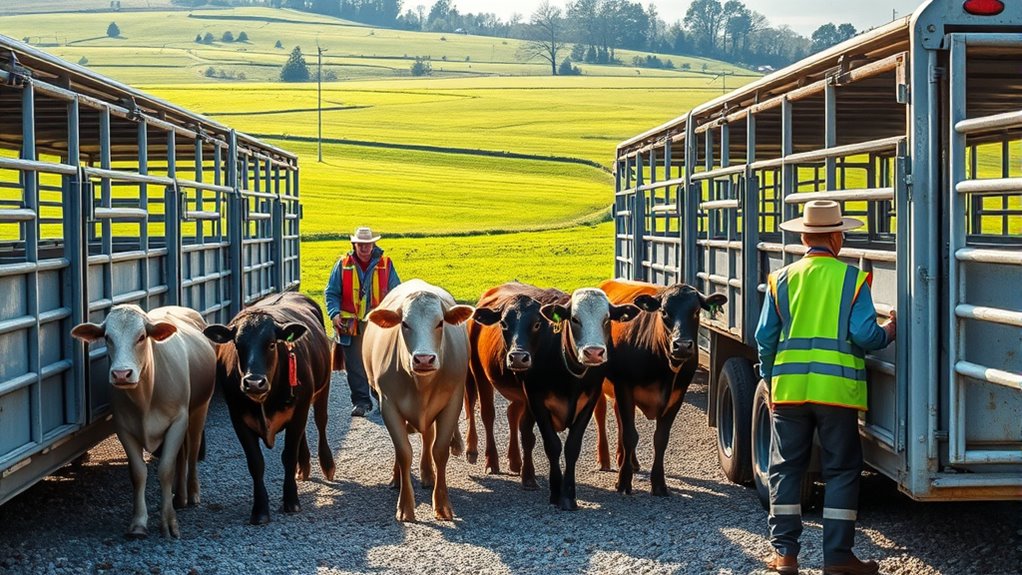
Choosing the right transportation equipment and vehicles is essential for ensuring livestock arrive safely and in good condition. You need to select vehicles that are well-ventilated, clean, and equipped to handle the size and type of animals you’re transporting. Make sure the floor is non-slip to prevent injuries, and the interior space provides enough room for animals to stand comfortably without overcrowding. Consider the vehicle’s capacity to avoid overloading, which can stress animals and cause injuries. Properly maintained equipment reduces breakdown risks and ensures smooth transportation. It’s also important to verify that the vehicle complies with local regulations and animal welfare standards. Using appropriate equipment minimizes stress, prevents injuries, and ensures animals arrive healthy and ready for market. Additionally, selecting appropriate accessories such as padding or partitions can further protect livestock during transit.
Implementing Safe and Effective Loading Techniques

Proper loading techniques are essential to guarantee animals enter the transport vehicle safely and with minimal stress. You should approach animals calmly and confidently, avoiding sudden movements or loud noises that could startle them. Use well-placed ramps that are non-slip and at an appropriate angle to prevent injuries. Lead animals one at a time, ensuring they follow your guidance without hesitation. Keep movement steady and consistent, giving clear signals to direct them onto the vehicle. Avoid overcrowding the ramp or forcing animals, as this increases stress and risk of injury. Instead, use gentle pressure and positive reinforcement where appropriate. Properly secured and evenly distributed animals during loading help maintain balance and safety throughout transit. Additionally, observing celebrity lifestyle insights can inspire innovative thinking for designing comfortable and safe transport environments for livestock.
Managing Stress and Minimizing Handling During Transit
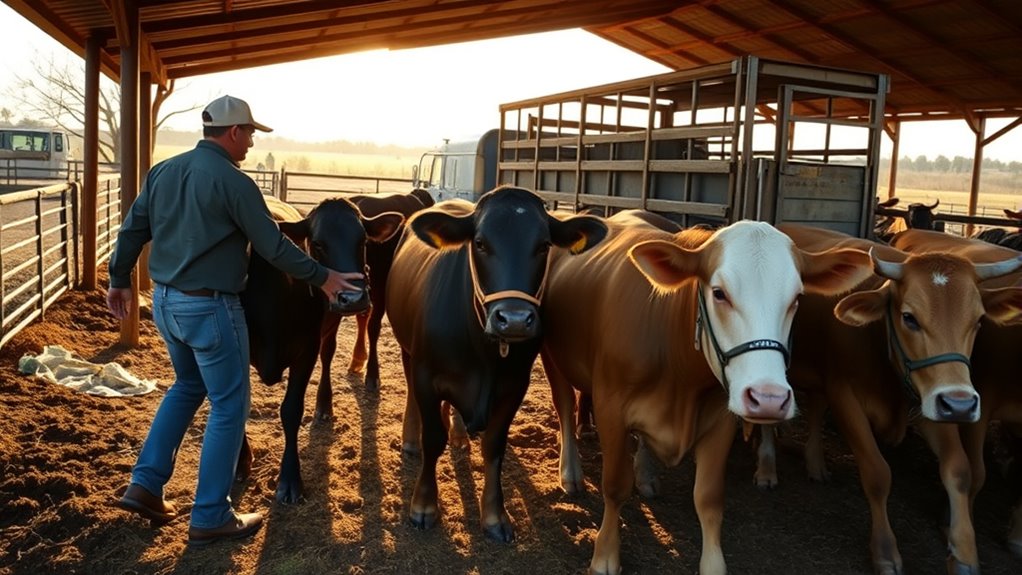
To effectively manage stress during transit, it’s essential to minimize handling and disturbances that can unsettle livestock. Keep movement smooth and predictable, avoiding sudden stops or sharp turns. Use calm, quiet voices to reassure animals and reduce noise levels inside the transport vehicle. Ensure the vehicle is well-ventilated and at a comfortable temperature to prevent heat stress or chills. Limit unnecessary interactions with the animals once they’re loaded; avoid poking or prodding unless absolutely necessary. Properly secured and padded partitions can prevent injuries and reduce shifting that causes discomfort. Maintaining a steady pace and avoiding rough driving minimizes vibrations and jostling. Additionally, choosing appropriate transport conditions can significantly influence stress levels and overall animal well-being. Overall, your goal is to create a calm environment that reduces fear and physical stress, helping livestock arrive at their destination healthier and less anxious.
Monitoring Livestock Throughout the Journey
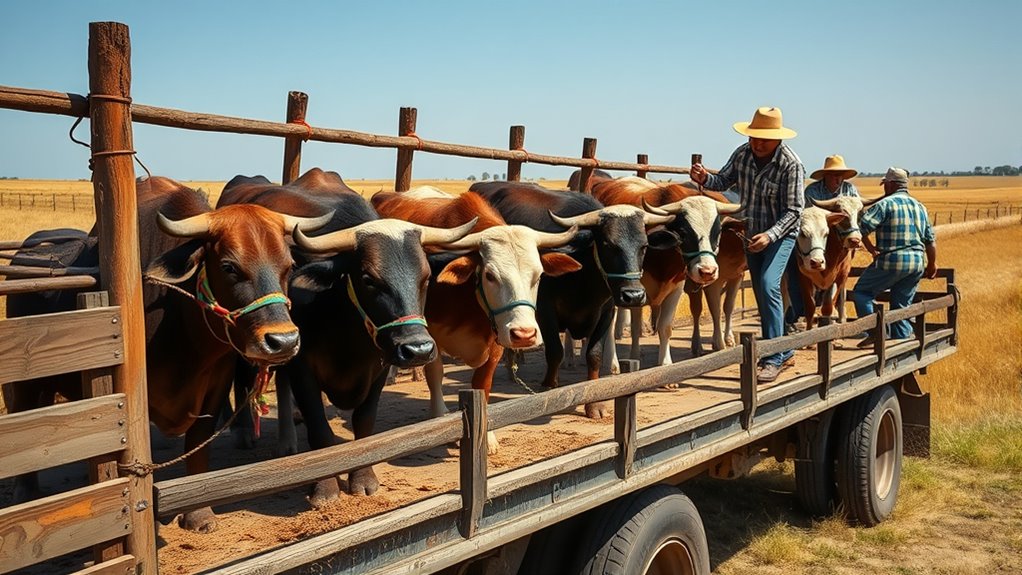
Monitoring livestock throughout the journey is essential to guarantee their well-being and promptly address any issues that arise. Keep a close eye on their behavior, condition, and environment during transit. Regularly check for signs of stress, dehydration, or injury, and ensure they are standing or lying comfortably. Use visual inspections to identify problems early, such as overheating or illness. Make sure ventilation systems are functioning properly to maintain fresh air and proper temperature. If you notice any livestock showing signs of distress, take immediate action, whether it’s adjusting ventilation, providing water, or reducing movement. Consistent monitoring helps prevent serious health issues, minimizes stress, and guarantees a safe, smooth journey for your animals. Additionally, understanding industry transformations like AI automation can improve monitoring techniques and overall transport management.
Complying With Regulations and Documentation Requirements
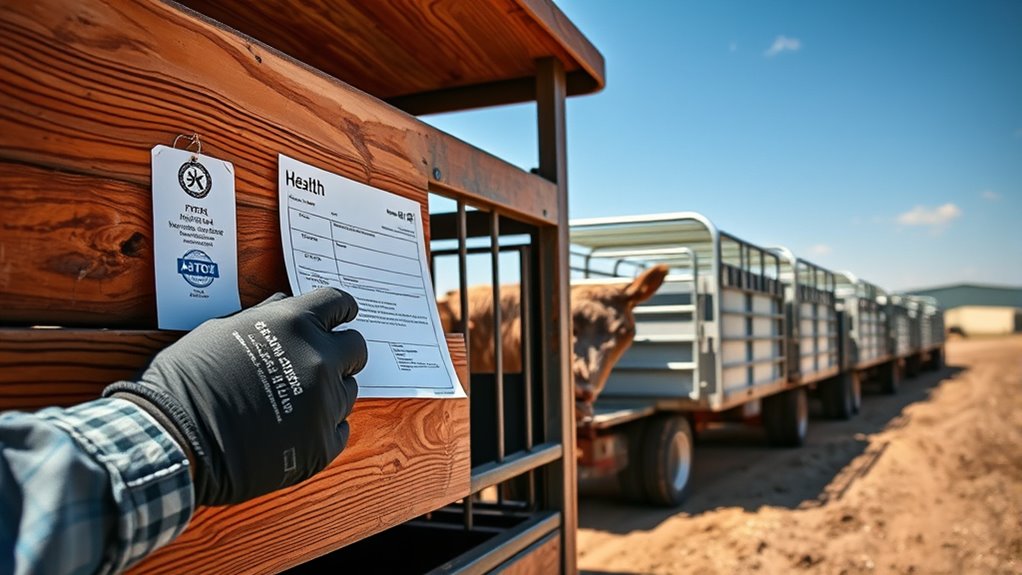
To guarantee smooth transport, you need to have all the necessary permits and licenses in place before you start. Keep detailed records and documentation of your livestock’s health and transport details to meet regulatory standards. Regular inspection and compliance checks help you stay on top of requirements and avoid delays or penalties. Ensuring proper documentation can also assist in identifying issues early, preventing potential complications during transit.
Necessary Permits and Licenses
Ensuring you have the proper permits and licenses is essential before transporting livestock, as failing to do so can lead to delays, fines, or even legal trouble. You need to obtain specific permits from local, state, or federal agencies depending on your location and the type of livestock. For example, interstate transport often requires a health certificate and movement permit issued by veterinary authorities. Some regions also mandate permits for transporting certain species or quantities. Before departure, verify that all permits are current and correctly issued. Keep copies accessible during transport in case authorities request verification. Failing to secure the necessary documentation can halt your journey, incur penalties, or compromise the health status of your livestock. Proper permits help ensure a smooth, compliant transport process. Additionally, understanding the support hours and regulations for your specific area can help prevent unexpected delays during your journey.
Recordkeeping and Documentation
Have you organized all the necessary records and documentation before transporting livestock? Proper recordkeeping is essential to ensure compliance with regulations and smooth transit. You need to maintain up-to-date documents like health certificates, vaccination records, and movement permits. Accurate records help verify livestock health and origin, reducing delays. To visualize, consider this simple overview:
| Document Type | Purpose |
|---|---|
| Health Certificates | Confirm animal health status |
| Vaccination Records | Show compliance with disease control |
| Transportation Permits | Legal authorization for transit |
| Ownership Documents | Prove livestock ownership |
| Inspection Records | Track previous inspections and checks |
Keeping these organized ensures you’re prepared for inspections and legal requirements, minimizing disruptions during market season.
Inspection and Compliance Checks
Before transporting livestock, you must verify that all inspection and compliance checks are complete and up-to-date. Ensuring your animals meet regulatory standards helps prevent delays and fines. Here’s what you should verify:
- Confirm all health certificates are current and signed by a licensed veterinarian.
- Check that your livestock pass all required inspection and disease testing protocols.
- Ensure all documentation, like transport permits and movement orders, are properly filled out.
- Verify that your vehicle and equipment meet safety and sanitation standards.
Completing these steps minimizes the risk of violations and ensures smooth transport. Staying compliant not only protects your livestock but also helps you avoid costly penalties. Always double-check your paperwork before loading your animals.
Planning for Unforeseen Events and Emergency Preparedness
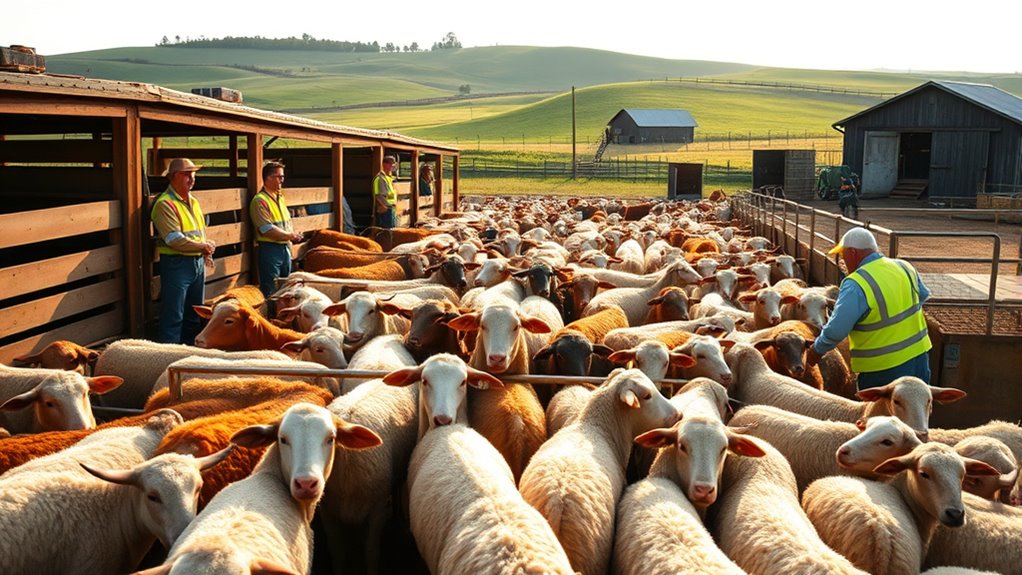
Planning for unforeseen events and emergency situations is essential to guarantee livestock safety during transport. You should prepare a detailed emergency plan that includes possible scenarios like vehicle breakdowns, accidents, or sudden weather changes. Keep a well-stocked emergency kit nearby, including first aid supplies, extra feed, water, and tools. Make certain your vehicle is regularly maintained and inspected to prevent breakdowns. Establish clear communication channels with drivers, handlers, and emergency services. Practice emergency drills to familiarize everyone with procedures. Always have backup plans, such as alternate routes or additional transport options. By proactively preparing for unexpected events, you minimize risks and can respond swiftly, protecting your livestock and ensuring they reach their destination safely.
Frequently Asked Questions
How Can I Identify Signs of Illness in Livestock Before Transport?
You can spot signs of illness in livestock by observing their behavior and physical condition. Look for drooping ears, nasal discharge, coughing, or labored breathing. Check their eyes for clarity and alertness, and feel their body temperature for fever. Watch for reluctance to move or decreased appetite. If you notice these signs, consult a veterinarian before transport to verify the animals’ health and prevent spreading illness.
What Are the Best Practices for Handling Livestock to Reduce Injury?
You’d think handling livestock carefully is obvious, but it’s often overlooked. To reduce injury, approach animals calmly and confidently, avoiding sudden movements. Use gentle, steady pressure and handle them in a quiet environment. Make certain equipment is in good condition, and don’t overcrowd pens or trucks. Regularly check for signs of stress or discomfort, and always prioritize their safety—after all, a calm animal is less likely to get hurt.
How Do I Determine the Ideal Transport Duration for Different Animals?
You determine the ideal transport duration by considering each animal’s age, health, and species. Younger or stressed animals need shorter trips to minimize fatigue, while hardy animals can handle longer journeys. Check for signs of stress or fatigue during transit, and plan routes that minimize travel time and stops. Always follow industry guidelines and consult with a veterinarian or livestock expert to guarantee animals’ well-being throughout transport.
What Are Common Mistakes to Avoid During Livestock Loading?
You don’t want to startle or stress your animals during loading. Avoid rushing, as it can cause injuries and panic. Keep the pathway clear and calm, using gentle signals and proper equipment. Never force animals onto the trailer; instead, guide them patiently. Watch for signs of distress, and if animals hesitate, back up and approach calmly. A smooth, confident approach minimizes stress and guarantees a safe, efficient load.
How Can I Ensure Compliance With Local and International Transport Regulations?
You can guarantee compliance by thoroughly researching and understanding all relevant local and international regulations before transport. Keep updated on any legal changes and maintain accurate documentation, such as health certificates and permits. Regularly train your staff on proper handling and documentation procedures. Also, consult with transportation authorities or industry experts to clarify regulations and best practices, making sure your livestock transport meets all legal standards and avoids penalties.
Conclusion
By preparing your livestock with care and attention, you’re guiding them safely through the journey like a steady captain steering a ship through calm waters. Every step you take, from health checks to emergency plans, acts as a sturdy anchor preventing chaos at sea. When you prioritize their well-being, you’re not just transporting animals; you’re ensuring their comfort and safety ride smoothly on a well-charted course, turning a potentially turbulent voyage into a peaceful passage.

